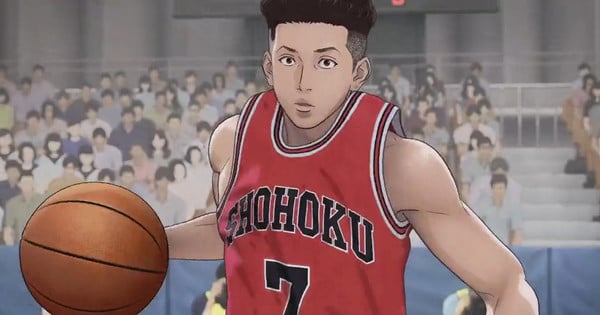Curated From www.animenewsnetwork.com Check Them Out For More Content.

©I.T.PLANNING,INC. ©2022 THE FIRST SLAM DUNK Film Partners
Most sports movies ground themselves in the drama and families surrounding a sport, instead of creating tension within the designs and dynamics that make the chosen game so popular in the first place. The Sandlot is one of the most well-known baseball movies not because of how it depicts the intricacies of and people’s relationship to the sport, but because it generates so much nostalgia for an early 1960s America. Similarly, The Blindeside is less about what it’s like to be a high school football player and more about how the sport changed the life of player Michael Oher as well as his relationship with his adoptive family and is also totally bogus. On the other hand, The First Slam Dunk is structured around a single game of high school basketball and masterfully depicts that experience.
Written and directed by Takehiko Inoue, the mangaka behind the original Slam Dunk manga, The First Slam Dunk loves basketball as much as I do. I’ve played basketball since I was a kid, and I don’t think I’d be the person I am today if I hadn’t. My team only won a handful of games while I played from fourth to twelfth grade, but that’s how I learned that success isn’t the end-all goal of any pursuit. As I learned and played the sport, basketball taught me there’s value in dedicating yourself to a craft, as it brings fulfillment and often comradery. It taught me to follow my passions regardless of how immediately gratifying they are, and I don’t know if I’d be here writing about anime if I hadn’t learned that lesson early in life.
From the get-go, The First Slam Dunk recognizes why basketball means so much to so many people. This film avoids many of the pitfalls other sports anime fall into and knows that basketball is a compelling enough game to entertain on its own merits. The movie brilliantly translates the experience and attitude of being on the court to the medium of animation, and if you’ve so much as touched a basketball, you should watch it.
While they only pop off internationally once in a blue moon, sports series have historically been some of the most popular in the manga and anime mediums. Manga focusing on baseball, martial arts, and kendo are some of the first to appear in Shonen Jump, and it’s impossible to spend much time in the anime fandom without hearing about titles like Haikyu!!, Blue Lock, Prince of Tennis, or Captain Tsubasa. However, there are two distinct flavors of sports series, and knowing their differences is vital to understanding the genre.
There are the kind that inserts broader genre tropes into the narrative and plot to appeal to their audience and the kind that focuses on the realities and intricacies of the game. A great example of this dichotomy appears when comparing Speed Racer and Initial D. While both are seminal anime focusing on racing, the former is wacky and fantastical, and the latter is an earnest depiction of Japanese street racing and its surrounding culture. Neither is inherently better than the other, but their approach to covering their shared subject matter couldn’t be more different.
The First Slam Dunk is one of the most grounded sports anime out there, with events and plot developments never becoming more outrageous than what you might see in an actual basketball game. The movie sets the competency of its players to that of actual high schoolers, albeit those who are some of the best to play at their age. Especially compared to basketball anime contemporaries, like the often outrageous Kuroko’s Basketball, watching The First Slam Dunk feels like you’re tuning into a real basketball game. This makes the movie all the more impactful to anyone who’s ever played the sport.
The editing choices in The First Slam Dunk first tipped me off to the movie being created by basketball fans and players for basketball fans and players. Repeatedly during the championship game between underdogs Shohoku and rich-kid private school Sannoh, a player will get absolutely stuffed while taking a shot or trying to drive to the basket. The film depicts this experience with a hard cut to a frame or a slow-motion shot of an opposing player appearing out of nowhere to stop the ball against an all-white background. While this directional choice could be dismissed as poor blocking or an easy way to convey this action in an animated medium, I’m here to say that I’ve never seen a piece of media so wholly capture the surprise and humiliation of getting blocked during a basketball game.
When you are playing in a close basketball game that matters, you are dialed in. When you see a player slightly out of position or momentarily distracted, you lunge at the opportunity to score. When you decide to make a basket, the world around you usually fades away, and you are singularly focused on completing that goal. For someone to step in unexpectedly and stop you is as jarring as it is humbling, and The First Slam Dunk expertly portrays this unique sensation.
The movie has so many other moments and situations that only fully land if you have some on-court experience beyond this one. No other media expresses what it’s like to go up against a zone press as a seventeen-year-old as well as this movie does! For those unfamiliar, a zone press is when two or more players aggressively guard the other team’s point guard during an inbound pass to stop them from setting up a play or getting the ball across the halfcourt line. It’s a really aggressive defensive strategy that uses a team’s deeper bench to bully a point guard into turning over the ball.

©I.T.PLANNING,INC. ©2022 THE FIRST SLAM DUNK Film Partners
Playing against a zone press is deeply frustrating, and seeing the film’s lead, Ryota Miyagi, go through it unlocked my repressed experience on the receiving end of that defense. Unless your team adjusts their inbounding play quickly or your point guard has tremendous ball-handling skills, it can feel impossible to escape from this oppressive defense, and it is soul-crushing to watch the score gap widen as it happens.
However, The First Slam Dunk also beautifully captures how a team can regain momentum while playing against this defense…by having the refs miss what should have been a foul, getting a rebound, and finally scoring again on a fast break! This moment in the film is both relatable and indicative of how much this film understands the sport of basketball. While many basketball stories moralize against this kind of dirty play, anyone who’s played the game will say that points on the board count the same no matter how you get them and that you’re allotted fouls for a reason. There’s no morality in a game of basketball as it’s fundamentally two teams fighting tooth and nail to win, and this movie is so much better than its contemporaries for understanding this simple fact.

©I.T.PLANNING,INC. ©2022 THE FIRST SLAM DUNK Film Partners
The First Slam Dunk also perfectly captures the attitude and mentality of basketball players. That shoulda-been-a foul was committed by Shohoku’s Hanamichi Sakuragi, the worst player on their starting lineup, but the heart and soul of their team. While he scores a middling amount of points over the game, he works harder on defense than anyone else and got that rebound moments after making a fool of himself to bring his teammates out of their funk. I cannot stress the importance of having someone on a team who keeps the energy up. My favorite professional team, the Milwaukee Bucks, won the championship title in 2021 thanks in no small part to PJ Tucker acting personally insulted every time a foul was levied against him and his willingness to square up against Kevin Durant’s personal security when they stormed the court to harass him. This kind of player motivates a team and makes their passion to win all the more intense. My high school team didn’t have anyone who could light a fire under us, and that’s why we sucked!
The depiction of this mentality and the personalities of other players in The First Slam Dunk through little moments made me realize that this film understood basketball the way only former players can. Is Ryota’s ritual of looking at the slogan written on his hand to get pumped up during a game kind of hokey? Absolutely! But it’s the exact kind of silly and sentimental thing that real athletes do to psych themselves up before or during a game. There’s also so much good trash talk in this movie! Masashi’s quick flex on Akagi after dunking through the latter’s guard was hilarious and deliberately foul-avoidant, just like the kind of small stunts players pull in actual games.
This movie is even spot on with minute details! Mitsui’s beat-long pause before shooting is the kind of thing drilled into players by coaches over hours of practice so they can instinctively put the right angle and amount of power on a shot. Ryota’s expression of surprise as he and Hanamichi open the game by scoring an alley-oop is also as endearing as it is relatable. Especially at a high school level, you don’t practice that kind of play as it’s more important to have fundamentals down pat and offensive screen patterns memorized. Successfully executing an alley-oop — one of the coolest ways to make a basket — for the first time during a game would trip up a less confident player like Ryota, and the ever-self-aggrandizing Hanamichi would try to no-sell it while quietly being proud of himself. This tiny scene at the beginning of the film has two people expressing themselves through the sport of basketball, which is precisely what makes the sport so interesting!
The personality and humanity of the people involved in a game are what make sports broadly appealing. Still, basketball’s fast-paced nature and emphasis on small-team coordination, in particular, make a game a series of celebrations and disappointments between teammates. This is why I and so many others love basketball. Even if the plot is mostly a series of — still very fun — sports cliches, The First Slam Dunk gets basketball on a deeper level than any other piece of media I’ve experienced, and I cannot recommend it enough for that.

